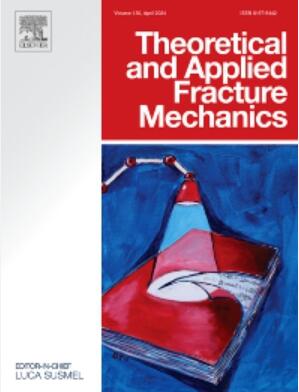Fracture behavior and failure mechanisms of concrete-rock interfaces with interfacial grouting
IF 5
2区 工程技术
Q1 ENGINEERING, MECHANICAL
引用次数: 0
Abstract
The fracture of the concrete-rock interface poses a significant challenge in practical engineering applications, often leading to structural failure. Grouting reinforcement has been demonstrated to enhance the mechanical properties of this interface. This study systematically investigates the fracture behavior and mechanisms of defective concrete-rock interfaces under various loading angles (0°, 30°, 45°, 60°, and 90°). Gypsum- and epoxy resin-based grouting materials were utilized to fill defects in concrete-sandstone composite specimens, with subsequent Brazilian splitting tests conducted on both ungrouted and grouted samples. Real-time monitoring of micro-crack initiation and propagation in the concrete-sandstone composite Brazilian disks was achieved through synchronized acoustic emission (AE) and digital image correlation (DIC) techniques. The experimental results reveal that the peak loads for ungrouted specimens at respective loading angles are 3.4 kN, 3.7 kN, 3.9 kN, 4.4 kN, and 4.9 kN. Gypsum-grouted specimens exhibited load increases of 0.7 kN, 2.1 kN, 2.3 kN, 2.1 kN, and 2.7 kN, whereas epoxy resin-grouted specimens demonstrated significantly greater enhancements of 3.5 kN, 4.7 kN, 4.8 kN, 4.9 kN, and 4.9 kN. Notably, epoxy resin grouting substantially improves both mechanical properties and interfacial adhesion in defective concrete-sandstone composites. Three key patterns emerge in AE amplitude entropy prior to failure: Low frequency and minor variations in amplitude, low frequency and large variations in amplitude, and high-frequency and significant variation in amplitude. These findings provide critical insights for optimizing grouting reinforcement strategies and enhancing risk assessment in composite structural engineering.
界面注浆混凝土-岩石界面破坏行为及破坏机制
在实际工程应用中,混凝土-岩石界面的断裂是一个重大挑战,经常导致结构破坏。注浆加固可提高该界面的力学性能。本研究系统研究了不同加载角度(0°、30°、45°、60°和90°)下混凝土-岩石界面缺陷的断裂行为和机制。采用石膏基和环氧树脂基灌浆材料对混凝土-砂岩复合试件进行缺陷充填,并对未灌浆和灌浆试件进行巴西劈裂试验。通过同步声发射(AE)和数字图像相关(DIC)技术,实现了混凝土-砂岩复合材料巴西盘中微裂纹萌生和扩展的实时监测。试验结果表明:不同加载角度下,未灌浆试件的峰值荷载分别为3.4 kN、3.7 kN、3.9 kN、4.4 kN和4.9 kN。石膏灌浆试件的载荷增幅分别为0.7 kN、2.1 kN、2.3 kN、2.1 kN和2.7 kN,而环氧树脂灌浆试件的载荷增幅分别为3.5 kN、4.7 kN、4.8 kN、4.9 kN和4.9 kN。值得注意的是,环氧树脂灌浆大大改善了缺陷混凝土-砂岩复合材料的力学性能和界面附着力。失效前声发射振幅熵出现三种关键模式:低频振幅变化较小,低频振幅变化较大,高频振幅变化较大。这些研究结果为优化注浆加固策略和加强复合结构工程的风险评估提供了重要见解。
本文章由计算机程序翻译,如有差异,请以英文原文为准。
求助全文
约1分钟内获得全文
求助全文
来源期刊

Theoretical and Applied Fracture Mechanics
工程技术-工程:机械
CiteScore
8.40
自引率
18.90%
发文量
435
审稿时长
37 days
期刊介绍:
Theoretical and Applied Fracture Mechanics'' aims & scopes have been re-designed to cover both the theoretical, applied, and numerical aspects associated with those cracking related phenomena taking place, at a micro-, meso-, and macroscopic level, in materials/components/structures of any kind.
The journal aims to cover the cracking/mechanical behaviour of materials/components/structures in those situations involving both time-independent and time-dependent system of external forces/moments (such as, for instance, quasi-static, impulsive, impact, blasting, creep, contact, and fatigue loading). Since, under the above circumstances, the mechanical behaviour of cracked materials/components/structures is also affected by the environmental conditions, the journal would consider also those theoretical/experimental research works investigating the effect of external variables such as, for instance, the effect of corrosive environments as well as of high/low-temperature.
 求助内容:
求助内容: 应助结果提醒方式:
应助结果提醒方式:


